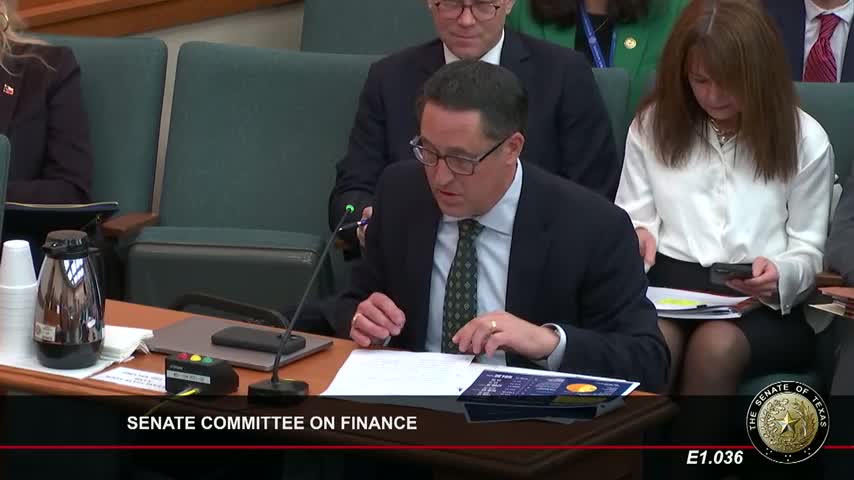Comptroller Hager: Texas has $19.46 billion available for general purpose spending; ESF cap will alter future transfers
January 27, 2025 | Senate, Legislative, Texas
This article was created by AI summarizing key points discussed. AI makes mistakes, so for full details and context, please refer to the video of the full meeting. Please report any errors so we can fix them. Report an error »

Comptroller Glenn Hager told the Senate Finance Committee the biennial revenue estimate (BRE) shows “$19,460,000,000 available for general purpose spending” for the upcoming biennium, and provided a breakdown of carryforward cash, tax, and non‑tax receipts that underlie the estimate.
Hager said the current projected ending balance includes a carryforward balance from the current biennium and that the make‑up of the ending balance differs from the record carryforward two years earlier. “The projected ending balance in this BRE has a very different makeup,” he said, pointing to conservative fiscal management after the pandemic windfall and noting that much of the recent balance sits in general‑revenue‑dedicated accounts.
The comptroller spent considerable time explaining how severance tax transfers interact with the Economic Stabilization Fund (ESF, also called the rainy‑day fund). He said partial transfers to the State Highway Fund and planned limits on transfers to the ESF have led to a projected ESF balance that will hit its constitutional cap early in the next biennium. When the cap is reached, 37.5% of severance taxes that would otherwise go to the ESF will remain in general revenue instead, Hager said, and he urged lawmakers to consider whether to leave the cap in place or seek a constitutional change that would allow more transfers into the ESF.
“1 question that deserves your attention is whether part of the severance taxes should continue to go into the ESF for future generations or should the cap remain in place and thus those severance taxes flow back into general revenue from here forward,” Hager said. He also walked through projected oil prices and severance‑tax collections that feed the estimates, and explained that the ESF now earns investment income rather than being kept in cash — a structural change that increases long‑term purchasing power of the fund.
Committee members pressed Hager on the specifics — including how much severance tax revenue would remain in general revenue if the cap binds, how much the state would transfer to the State Highway Fund, and how federal dollars and COVID‑era spending changes affected the BRE. Hager’s briefing set the technical baseline the committee will use while reviewing SB1 and agency requests.
Why it matters: The comptroller’s revenue estimate limits the total amount available for general fund spending and affects the Senate’s choices on property tax relief, one‑time investments, and ongoing commitments. The discussion about the ESF cap frames a major policy decision: whether to preserve the constitutional cap or raise it (a voter referendum) with consequences for transfers into long‑term savings versus near‑term general‑revenue spending.
Hager said the current projected ending balance includes a carryforward balance from the current biennium and that the make‑up of the ending balance differs from the record carryforward two years earlier. “The projected ending balance in this BRE has a very different makeup,” he said, pointing to conservative fiscal management after the pandemic windfall and noting that much of the recent balance sits in general‑revenue‑dedicated accounts.
The comptroller spent considerable time explaining how severance tax transfers interact with the Economic Stabilization Fund (ESF, also called the rainy‑day fund). He said partial transfers to the State Highway Fund and planned limits on transfers to the ESF have led to a projected ESF balance that will hit its constitutional cap early in the next biennium. When the cap is reached, 37.5% of severance taxes that would otherwise go to the ESF will remain in general revenue instead, Hager said, and he urged lawmakers to consider whether to leave the cap in place or seek a constitutional change that would allow more transfers into the ESF.
“1 question that deserves your attention is whether part of the severance taxes should continue to go into the ESF for future generations or should the cap remain in place and thus those severance taxes flow back into general revenue from here forward,” Hager said. He also walked through projected oil prices and severance‑tax collections that feed the estimates, and explained that the ESF now earns investment income rather than being kept in cash — a structural change that increases long‑term purchasing power of the fund.
Committee members pressed Hager on the specifics — including how much severance tax revenue would remain in general revenue if the cap binds, how much the state would transfer to the State Highway Fund, and how federal dollars and COVID‑era spending changes affected the BRE. Hager’s briefing set the technical baseline the committee will use while reviewing SB1 and agency requests.
Why it matters: The comptroller’s revenue estimate limits the total amount available for general fund spending and affects the Senate’s choices on property tax relief, one‑time investments, and ongoing commitments. The discussion about the ESF cap frames a major policy decision: whether to preserve the constitutional cap or raise it (a voter referendum) with consequences for transfers into long‑term savings versus near‑term general‑revenue spending.
View full meeting
This article is based on a recent meeting—watch the full video and explore the complete transcript for deeper insights into the discussion.
View full meeting
